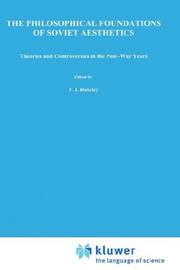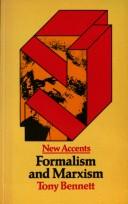| Listing 1 - 7 of 7 |
Sort by
|
Book
ISBN: 2717816798 Year: 1989 Publisher: Paris : Anthropos,
Abstract | Keywords | Export | Availability | Bookmark
 Loading...
Loading...Choose an application
- Reference Manager
- EndNote
- RefWorks (Direct export to RefWorks)
Aesthetics --- Brecht, Bertolt --- Lukács, Georg --- Communism and literature. --- Literature --- Realism in art --- Communist aesthetics --- Communisme et littérature --- Littérature --- Réalisme dans l'art --- Esthétique communiste --- Esthétique --- Brecht, Bertolt, --- Lukãcs, György, --- Criticism and interpretation. --- Communisme et littérature --- Littérature --- Réalisme dans l'art --- Esthétique communiste --- Esthétique --- Lukács, György,

ISBN: 9027709807 9400994362 9400994346 Year: 1979 Publisher: Dordrecht Reidel
Abstract | Keywords | Export | Availability | Bookmark
 Loading...
Loading...Choose an application
- Reference Manager
- EndNote
- RefWorks (Direct export to RefWorks)
Aesthetics, Russian --- Communist aesthetics --- Dialectical materialism --- Esthétique communiste --- Matérialisme dialectique --- -Communist aesthetics --- 82.01 --- Materialism, Dialectical --- Philosophy, Marxist --- Socialism --- Aesthetics, Communist --- Aesthetics, Marxist --- Marxist aesthetics --- Communism and art --- Russian aesthetics --- Esthetica --- Communist aesthetics. --- Dialectical materialism. --- 82.01 Esthetica --- Esthétique communiste --- Matérialisme dialectique

ISBN: 0416708706 0416708803 9780416708806 9780416708707 Year: 1979 Publisher: London Methuen
Abstract | Keywords | Export | Availability | Bookmark
 Loading...
Loading...Choose an application
- Reference Manager
- EndNote
- RefWorks (Direct export to RefWorks)
Communist aesthetics --- Formalism (Literary analysis) --- Criticism --- Literature --- Esthétique communiste --- Formalisme (Littérature) --- Critique --- Littérature --- Aesthetics --- Esthétique --- Esthétique communiste --- Formalisme (Littérature) --- Criticism, Marxist --- Marxian criticism --- Formalism (Russian literature) --- Russian formalism (Literary analysis) --- Formalism (Literary analysis). --- Marxist criticism --- Marxist literary criticism --- Communism and literature --- Marxist criticism.
Book
ISBN: 9783948318161 3948318166 Year: 2022 Publisher: Berlin Weiss Publications
Abstract | Keywords | Export | Availability | Bookmark
 Loading...
Loading...Choose an application
- Reference Manager
- EndNote
- RefWorks (Direct export to RefWorks)
In 1968, lauded American architect Mary Otis Stevens (born 1928) and her partner, fellow architect Thomas McNulty (1919–84), initiated i Press, the influential imprint that focuses on the social context of architecture. Over the next five years, the duo released five books under the thematic umbrella of “Human Environment” with the publisher George Braziller. The first of this series, The Ideal Communist City (1969) is an English translation of urban concepts advanced by architects and planners from the University of Moscow. The book was first published in a Soviet journal of a communist youth organization in 1960 and was then republished in Italy in 1968. Offering a new way of thinking about mobility, equity and social interaction in neighborhood planning, The Ideal Communist City was a direct response to suburban development and its focus on private spaces for family life: “the new city is a world belonging to all and each” where life is “structured by freely chosen relationships representing the fullest, most well-rounded aspects of each human personality.”This publication is a facsimile of The Ideal Communist City, with additional texts by architectural historians and the editors.
City planning --- Communist aesthetics. --- Communism and architecture --- Urbanisme --- Esthétique communiste --- Communisme et architecture --- Philosophy. --- Philosophie --- Architectuurtheorie ; stedenbouw ; onderzoek ; research --- Stedenbouw ; denken over ; 20ste eeuw --- Architectuurtheorie- en geschiedenis ; sleutelwerken --- Stedenbouw ; theorie ; 20ste eeuw --- Architectuur ; Sovjet-Unie ; 20ste eeuw --- Communisme --- De Carlo, Giancarlo --- 711.4(A) --- Stedenbouw. Ruimtelijke ordening ; denken over de stedenbouw
Book
ISBN: 9781350166189 1350166189 9781350014442 9781350014428 9781350014435 1350014435 1350014443 Year: 2021 Publisher: London : ©2019 Bloomsbury Academic,
Abstract | Keywords | Export | Availability | Bookmark
 Loading...
Loading...Choose an application
- Reference Manager
- EndNote
- RefWorks (Direct export to RefWorks)
If postmodernism is indeed 'the cultural logic of late capitalism', why did typical postmodernist themes like ornament, colour, history and identity find their application in the architecture of the socialist Second World? How do we explain the retreat into paper architecture and theoretical discussion in societies still nominally devoted to socialist modernization? Exploring the intersection of two areas of growing scholarly interest - postmodernism and the architecture of the former socialist world - this edited collection stakes out new ground in charting architecture's various transformations in the 1970s and 80s. Fourteen essays together explore the question of whether or not architectural postmodernism had a specific Second World variant. The collection demonstrates both the unique nature of Second World architectural phenomena and also assesses connections with western postmodernism. The case studies cover the vast geographical scope from Eastern Europe to China and Cuba. They address a wealth of aesthetic, discursive and practical phenomena, interpreting them in the broader socio-political context of the last decades of the Cold War. The result provides a greatly expanded map of recent architectural history, which redefines postmodernist architecture in a more theoretically comprehensive and global way.
Architecture, Postmodern
---
Architecture and society
---
Communist aesthetics
---
Aesthetics, Communist
---
Aesthetics, Marxist
---
Marxist aesthetics
---
Communism and art
---
Architecture
---
Architecture and sociology
---
Society and architecture
---
Sociology and architecture
---
Postmodern architecture
---
Architecture, Modern
---
Postmodernism
---
Social aspects
---
Human factors
---
72.036 <0...>
---
72.036
---
72.036 Moderne bouwkunst. Architectuur van de 20e eeuw
---
Moderne bouwkunst. Architectuur van de 20e eeuw
---
72.036 <0...> Moderne bouwkunst. Architectuur van de 20e eeuw--
Book
ISBN: 2738490603 Year: 2001 Publisher: Paris L'Harmattan
Abstract | Keywords | Export | Availability | Bookmark
 Loading...
Loading...Choose an application
- Reference Manager
- EndNote
- RefWorks (Direct export to RefWorks)
Communist aesthetics --- Totalitarianism and literature --- Literature and society --- Esthétique communiste --- Totalitarisme et littérature --- Littérature et société --- History --- Histoire --- Russia --- Soviet Union --- Russie --- URSS --- Intellectual life --- Social conditions --- Vie intellectuelle --- Conditions sociales --- Intellectuals --- -Socialism and literature --- -Values --- -Violence --- -#SBIB:94H6 --- #SBIB:17H20 --- #SBIB:17H3 --- #SBIB:013.IEB --- Violent behavior --- Social psychology --- Axiology --- Worth --- Aesthetics --- Knowledge, Theory of --- Metaphysics --- Psychology --- Ethics --- Literature and socialism --- Literature --- Intelligentsia --- Persons --- Social classes --- Specialists --- Aesthetics, Communist --- Aesthetics, Marxist --- Marxist aesthetics --- Communism and art --- Moral and ethical aspects --- -Geschiedenis van Rusland en de landen van de USSR --- Sociale wijsbegeerte: algemeen --- Politieke wijsbegeerte --- -Intellectual life --- -Communist aesthetics. --- Socialism and literature --- Values --- Violence --- History. --- -Communist aesthetics --- Communist aesthetics. --- Esthétique communiste --- Totalitarisme et littérature --- Littérature et société --- #SBIB:94H6 --- Geschiedenis van Rusland en de landen van de USSR
Book
ISBN: 1421430568 1421430118 1421430967 Year: 2019 Publisher: Johns Hopkins University Press
Abstract | Keywords | Export | Availability | Bookmark
 Loading...
Loading...Choose an application
- Reference Manager
- EndNote
- RefWorks (Direct export to RefWorks)
Paulson retrieves an aesthetics that had strong support during the eighteenth century but has been obscured both by the more dominant academic discourse of Shaftesbury (and later Sir Joshua Reynolds) and by current trends in art and literary history. Arguing that the two traditions comprised not only painterly but also literary theory and practice, Paulson explores the innovations of Henry Fielding, John Cleland, Laurence Sterne, and Oliver Goldsmith, which followed and complemented the practice in the visual arts of Hogarth and his followers. In The Beautiful, Novel, and Strange Ronald Paulson fills a lacuna in studies of aesthetics at its point of origin in England in the 1700s. He shows how aesthetics took off not only from British empiricism but also from such forms of religious heterodoxy as deism. The third earl of Shaftesbury, the founder of aesthetics, replaced the Christian God of rewards and punishments with beauty - worship of God, with a taste for a work of art. William Hogarth, reacting against Shaftesbury's "disinterestedness," replaced his Platonic abstractions with an aesthetics centered on the human body, gendered female, and based on an epistemology of curiosity, pursuit, and seduction. Paulson shows Hogarth creating, first in practice and then in theory, a middle area between the Beautiful and the Sublime by adapting Joseph Addison's category (in the Spectator) of the Novel, Uncommon, and Strange.
Litterature et societe --- Art et litterature --- Roman anglais --- Litterature anglaise --- Esthetique --- Esthetica. --- Letterkunde. --- Engels. --- Literature and society. --- Fiction --- English fiction. --- Art and literature. --- Aesthetics, British. --- Literature and society --- Aesthetics, British --- Art and literature --- English fiction --- Histoire et critique. --- Technique. --- History --- History and criticism. --- 1700-1799 --- Great Britain. --- Visual arts --- Aesthetics --- Literature and art --- Literature and painting --- Literature and sculpture --- Painting and literature --- Sculpture and literature --- Literature --- Fiction writing --- Metafiction --- Writing, Fiction --- Authorship --- Aesthetics, English --- British aesthetics --- English aesthetics --- English literature --- Literature and sociology --- Society and literature --- Sociology and literature --- Sociolinguistics --- Social aspects --- Art, Théorie de l' --- Art --- Arts --- Contribution à l'esthétique --- Et l'esthétique --- Philosophie des arts --- Théorie artistique --- Théorie de l'art --- Théories artistiques --- Critique et interprétation --- Culture visuelle --- Esthétique --- Esthétique et droit --- Esthétique et morale --- Académisme --- Allusion --- Apollinien et dionysiaque --- Architecture --- Art pour l'art --- Auteur (esthétique) --- Authenticité (art) --- Avant-garde (esthétique) --- Beau (esthétique) --- Beauté féminine (esthétique) --- Camp (style) --- Catharsis --- Cinéma --- Comique --- Contemporanéité (esthétique) --- Création (esthétique) --- Déformation (esthétique) --- Dernières oeuvres --- Détails (philosophie) --- Dilettantisme (esthétique) --- Dimension (esthétique) --- Double (esthétique) --- Douceur --- Échelle (ordre de grandeur) --- Éclectisme (esthétique) --- Élégance --- Ellipse (esthétique) --- Empathie (esthétique) --- Entre-deux (esthétique) --- Épique (esthétique) --- Esthétique anarchiste --- Esthétique communiste --- Esthétique comparée --- Esthétique environnementale --- Esthétique fasciste --- Esthétique marxiste --- Esthétique national-socialiste --- Fantastique --- Fin de siècle (esthétique) --- Flou (esthétique) --- Force (esthétique) --- Forme (esthétique) --- Goût (esthétique) --- Grâce (esthétique) --- Grandiose (esthétique) --- Grotesque --- Harmonie (esthétique) --- Humour --- Imaginaire (philosophie) --- Imagination (philosophie) --- Immobilité (esthétique) --- Improvisation (esthétique) --- Informe (esthétique) --- Insignifiance (esthétique) --- Inspiration --- Ironie --- Jeu (philosophie) --- Jugement esthétique --- Kitsch --- Laideur --- Légèreté --- Littérature --- Médiévisme (esthétique) --- Modernisme (esthétique) --- Montage (esthétique) --- Mouvement (esthétique) --- Musique --- Nature (esthétique) --- Nouveauté --- Objet (esthétique) --- Orientalisme --- Originalité (esthétique) --- Peinture --- Pittoresque --- Poïétique --- Post-postmodernisme --- Postmodernisme --- Premières oeuvres --- Provocation (esthétique) --- Répétition (esthétique) --- Représentation (esthétique) --- Reste (esthétique) --- Ruines (esthétique) --- Rythme --- Silence (philosophie) --- Simultanéité (esthétique) --- Spectaculaire --- Stimmung --- Style --- Sublime --- Théâtre --- Tradition (philosophie) --- Transgression --- Valeurs (philosophie) --- Vulgarité --- Wabi-sabi --- Philosophie --- Littérature et art --- Littérature et arts plastiques --- Littérature et beaux-arts --- Littérature et peinture --- Littérature et sculpture --- Peinture et littérature --- Poésie et art --- Poésie et peinture --- Poésie et sculpture --- Sculpture et littérature --- Critique d'art --- Architecture et littérature --- Cubisme et littérature --- Ekphrasis --- Littérature et photographie --- Ut pictura poesis (esthétique) --- Arts et littérature --- Société et littérature --- Femmes et littérature --- Littérature et géographie --- Littérature postcoloniale --- Sociologie de la littérature --- Vie littéraire --- Féminisme et littérature --- Institution littéraire --- Psychologie sociale et littérature --- Histoire --- Aspect religieux --- Philosophie et esthétique --- Aspect social --- Esthétique et religion
| Listing 1 - 7 of 7 |
Sort by
|

 Search
Search Feedback
Feedback About
About Help
Help News
News